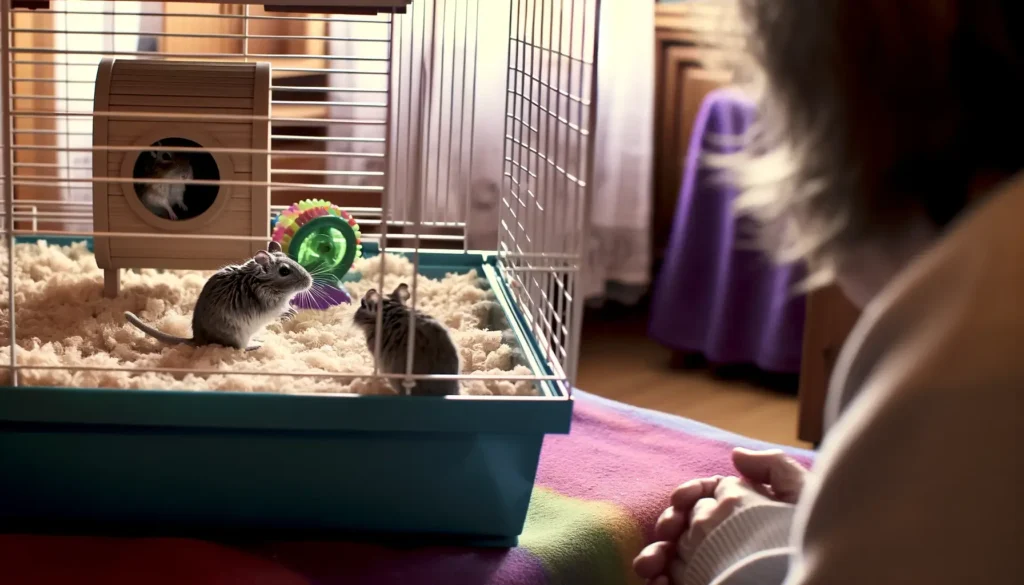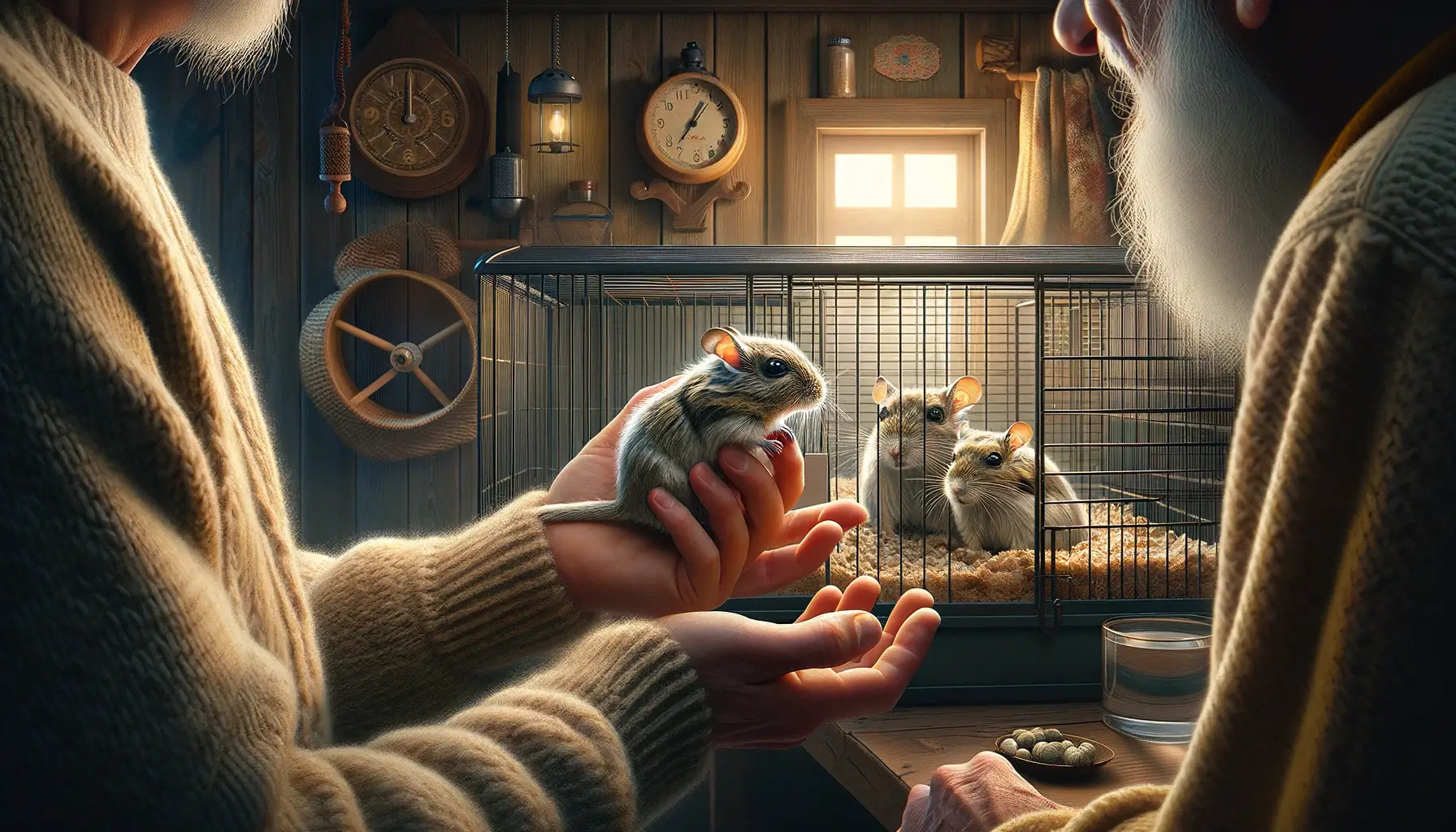Gerbils are social creatures that thrive on companionship. In the wild, they live in close-knit family groups, engaging in playful chases, grooming sessions, and communal nesting.
This social structure is crucial for their well-being, making the introduction of new gerbils a significant event for any gerbil owner. However, the process can be fraught with challenges due to their territorial nature.
In this article we will discuss the complexities of introducing new gerbils to each other, ensuring a smooth transition and harmonious cohabitation.
Understanding Gerbil Behavior
Before embarking on the introduction process, it’s essential to grasp the intricacies of gerbil behavior. In their natural habitat, gerbils form structured social groups, usually led by a dominant pair.
This hierarchy is vital for the group’s stability, influencing their behavior in captivity as well. Gerbils are inherently territorial, viewing newcomers with suspicion, which can lead to aggression if introductions are not handled carefully.
The key to a successful introduction lies in respecting their social and territorial instincts. By mimicking the conditions under which gerbils would naturally accept new members into their group, owners can facilitate a smoother integration process.
Understanding these behavioral cues is the first step toward creating a peaceful gerbil community in your home.
Preparing for Introduction

The preparation phase is crucial for setting the stage for a successful introduction. Selecting compatible gerbils is the first step. Younger gerbils, especially those around six to eight weeks old, tend to adapt more easily to new companions.
However, the sex of the gerbils also plays a significant role. Typically, male gerbils are more accepting of new company, whereas females can be more territorial.
Necessary Supplies and Environment Setup
A split cage is an invaluable tool for introducing new gerbils. This method allows the gerbils to get accustomed to each other’s scent without direct contact, reducing the risk of immediate aggression. Here’s what you’ll need to set up a split cage:
- A large enough cage or tank that can be securely divided into two separate sections.
- A divider, which can be made of mesh or clear plastic, allowing the gerbils to see and smell each other without physical contact.
- Two sets of water bottles, food dishes, and bedding, to ensure both sides of the split cage are equally equipped.
Scent Mixing Techniques
Scent plays a crucial role in the gerbil introduction process. Before placing the gerbils in the split cage, rub each gerbil gently with the same piece of bedding or cloth to mix their scents. This technique helps in making their scents familiar to each other, reducing the likelihood of aggressive behavior.
Also read: Can Gerbils Live Alone?
How to Introduce New Gerbils to Each Other?
With the preparations in place, you’re ready to begin the introduction process. Start by placing each gerbil on opposite sides of the split cage. For the first few days, observe their behavior closely.
Signs of aggression, such as excessive digging, chewing at the divider, or aggressive posturing, may indicate that more time is needed before they can safely interact.
After a few days of peaceful coexistence, you can start swapping the gerbils between the two sides of the cage.
This further familiarizes them with each other’s scent and presence. Continue this process for at least a week, gradually increasing their direct interaction under close supervision.
Step-by-Step Guide to the Split Cage Method
The split cage method is a tried-and-true approach to introducing gerbils, minimizing stress and aggression by allowing them to get accustomed to each other’s presence safely. Here’s how to execute it effectively:
- Initial Separation: Place each gerbil on opposite sides of the split cage, ensuring they have access to their own food, water, and bedding. This setup allows them to see and smell each other without direct contact.
- Observation: Monitor their behavior closely. Signs of curiosity, such as sniffing around the divider, are positive. Aggressive behaviors, however, indicate they need more time to adjust.
- Scent Swapping: After a few days, begin swapping bedding or toys between the sides to further mix their scents. This step is crucial for building familiarity.
- Physical Introduction: If after a week there are no signs of aggression, you can remove the divider for short, supervised interactions in a neutral space, like a playpen.
- Co-habitation: Gradually increase their time together. Once they show signs of bonding, such as grooming or sleeping together, they can be moved to the same side of the cage permanently.
Post-Introduction Care
After the gerbils have been successfully introduced, your role shifts to ensuring their continued harmony and well-being. Here are some tips for post-introduction care:
- Monitor for Signs of Declanning: Even after a successful introduction, gerbils can sometimes fall out. Regularly observe their interactions for any signs of aggression or bullying, and be prepared to intervene if necessary.
- Optimize Their Habitat: Ensure their shared space is large enough to provide separate areas for eating, sleeping, and playing. This helps reduce competition and stress.
- Regular Health Checks: Keep an eye on their health and behavior. Stress from introduction can sometimes lead to health issues, so it’s important to catch any signs early.
Special Considerations
Every gerbil is unique, and certain situations require special attention during the introduction process:
- Introducing Gerbils of Different Ages: Older gerbils can be introduced to younger ones, but the process may require more supervision. Younger gerbils are typically more adaptable, but respect the older gerbil’s pace.
- Health Issues: Gerbils with health issues may be more vulnerable to stress or aggression. In these cases, carefully weigh the benefits of introduction against the potential risks.
- When to Keep a Gerbil Alone: In some rare cases, it may be in the gerbil’s best interest to live alone, especially if they are particularly aggressive, elderly, or have health issues that could be exacerbated by the stress of introduction.
Introducing new gerbils to each other can be a rewarding experience that enhances their quality of life.
By following these guidelines and paying close attention to their needs and behaviors, you can help ensure a smooth and successful integration, providing your gerbils with the companionship they naturally desire.
Also read: How to Stop a Gerbil from Biting?
FAQs
Can You Introduce a New Gerbil to an Old Gerbil?
Yes, you can introduce a new gerbil to an older one, but it requires careful planning and supervision. Age differences can affect the dynamics of their relationship, with younger gerbils generally being more adaptable.
Utilize the split cage method to gradually acclimate them to each other’s presence, ensuring a smoother introduction.
How Long Does It Take for Gerbils to Get Used to Each Other?
The time it takes for gerbils to get used to each other can vary widely depending on their personalities, ages, and past experiences. Typically, the introduction process can take anywhere from a week to several weeks.
Patience is key, and closely monitoring their behavior for signs of acceptance or aggression will guide you in adjusting the pace of the introduction.
What If the Gerbils Start Fighting?
If the gerbils start fighting, immediately separate them to prevent injury. Fighting can be a sign that they were introduced too quickly or that their personalities may not be compatible.
After giving them some time to calm down, you can try reintroducing them more slowly, paying close attention to their reactions.
In some cases, it may be necessary to accept that certain gerbils cannot live together peacefully.
Is It Better to Introduce Male or Female Gerbils to Each Other?
Both male and female gerbils can be introduced to each other successfully, but their dynamics can differ. Males tend to form stable bonds with fewer dominance disputes once they’ve accepted each other.
Females, while capable of forming close bonds, may have more complex social hierarchies and can be more territorial. Regardless of gender, the key to a successful introduction lies in careful observation and a slow, gradual process.
Can Gerbils Live Alone After Being Part of a Pair or Group?
Gerbils are inherently social animals and thrive in the company of their kind. Living alone can lead to loneliness and boredom, which can affect their health and well-being.
If one gerbil is left alone due to the passing of a cage mate, it’s generally advisable to consider introducing a new companion. However, the individual gerbil’s health, age, and temperament should guide this decision.
How Can I Tell If My Gerbils Have Bonded Successfully?
Signs of a successful bond include sleeping together in a nest, grooming each other, and sharing food without aggression. These behaviors indicate that the gerbils have accepted each other and are comfortable sharing their space.
Continued observation is important, as dynamics can change, especially in the early stages of their relationship.
Conclusion
Introducing new gerbils to each other is a journey that requires patience, understanding, and a deep respect for their natural behaviors and needs. By carefully preparing their environment, closely monitoring their interactions, and gradually facilitating their acquaintance through the split cage method, you can significantly increase the chances of a successful introduction.
Remember, each gerbil is unique, and their individual personalities will play a crucial role in how smoothly the process unfolds.
With time, patience, and careful observation, you can help foster a harmonious relationship between your gerbil companions, enriching their lives with the social interaction they instinctively seek and thrive upon.











